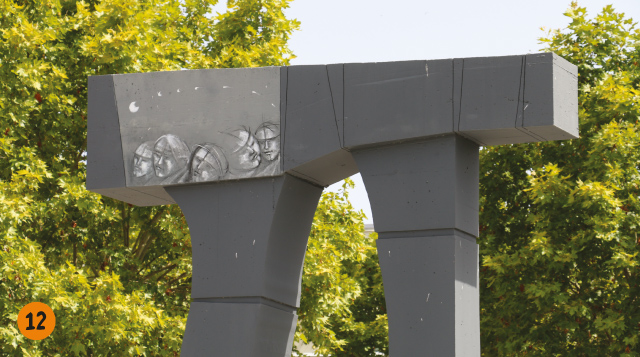Porta Du Sol

Obra – PT
12 – Título: Porta du Sol
A escultura monumental “Porta du Sol”, situada no Campo da Restauração em Ponte de Sor, apresenta uma estrutura vertical de betão em forma de ponte, precisamente para significar uma passagem contínua de diferentes culturas, uma mensagem de colaboração e amizade com todos os povos que vão além de todas as fronteiras.
Obra – ENG
12 – Title: Porta du Sol
The monumental sculpture “Porta du Sol”, located in Campo de Restauração in Ponte de Sor, features a vertical concrete structure in the form of a bridge, precisely to signify a continuous passage of different cultures, a message of collaboration and friendship with all peoples that go beyond all borders.
Paolo Grigó
Bio – PT
Depois de se formar no Instituto Estatal de Arte de Cascina (Toscana – Itália), Paolo Grigò continuou os seus estudos fazendo cursos académicos em Retrato e Gravura em Nu. Ele colaborou desde cedo com o Padre Renato, escultor e entalhador, com quem aprendeu as técnicas dessas disciplinas.
Foi muito importante ter frequentado o atelier do pintor florentino Gipi, que o apresentou à técnica do “Monótipo” numa variante pessoal, conhecida e preservada como presente de Paolo Grigó.
Iniciou a sua atividade artística em 1971, participando em exposições coletivas, nacionais e internacionais. A partir de 1985, o artista passou a apresentar as suas obras em ciclos.
As questões abordadas pelo artista estão muitas vezes ligadas a questões sociais, que suscitam reflexões profundas sobre a degradação física e moral desta civilização, dedicada ao consumismo e movida pela ganância e vanglória.
Há também o tema da viagem, muito caro ao artista que se define como “apátrida” ou cidadão do mundo, curioso explorador de outros povos e outros costumes. E é justamente nesse tema que ele trabalha desde 2018, criando o ciclo “Metropolitan Wayfarer”, coletando ideias de vida de viagens por terras próximas e distantes.
Entre as inúmeras exposições individuais que realizou, destacam-se importantes antologias de Pintura, Escultura e Gráfica em Itália, França, Portugal e Estados Unidos da América. Ele ilustrou livros de poesia, fez capas para revistas e volumes. Muitas das suas esculturas encontram-se em edifícios públicos, igrejas e em praças italianas, em Portugal, Cabo Verde, França, Espanha e Alemanha.
O Centro de Estudos de Vignola (Modena) o homenageou-o com a Placa de Ouro, pelo seu trabalho realizado como escultor.
Bio – ENG
After graduating from the State Institute of Art in Cascina (Tuscany – Italy), Paolo Grigò continued his studies by taking academic courses in Portrait and Printmaking in Nudes. He collaborated early on with Father Renato, sculptor and carver, with whom he learned the techniques of these disciplines.
It was very important to have attended the workshop of the Florentine painter Gipi, who introduced him to the “Monotype” technique in a personal variant, known and preserved as a gift from Paolo Grigó.
He started his artistic activity in 1971, participating in collective exhibitions, national and international. From 1985, the artist began to present his works in cycles.
The issues addressed by the artist are often linked to social issues, which give rise to profound reflections on the physical and moral degradation of this civilization, dedicated to consumerism and driven by greed and vainglory.
There is also the theme of the trip, very dear to the artist who defines himself as “stateless” or a citizen of the world, curious explorer of other peoples and other customs. And it is precisely on this theme that he has been working since 2018, creating the “Metropolitan Wayfarer” cycle, collecting life ideas from trips to near and far lands.
Among the numerous individual exhibitions he held, important highlights are anthologies of Painting, Sculpture and Graphics in Italy, France, Portugal and the United States of America. He illustrated poetry books, made covers for magazines and volumes. Many of his sculptures are found in public buildings, churches and in Italian squares, in Portugal, Cape Verde, France, Spain and Germany.
The Vignola Study Center (Modena) honored him with the Golden Plate, for his work as a sculptor.
